Ofcom – 75% of the United Kingdom Can Sign-up to Superfast Broadband
The UK telecoms regulator, Ofcom, has today published their annual 2014 Infrastructure Report and revealed that 75% of premises are now within reach of a superfast broadband (30Mbps+) connection (this falls to just 22% superfast coverage in rural areas or 33% for raw NGA reach), with take-up of related services hitting 22% (up from 16% last year).
As usual most of the movement towards Next Generation Access (NGA) broadband networks has come from BT (68% UK FTTC and some FTTP coverage) and Virgin Media (44% Cable / EuroDOCSIS coverage), while not forgetting the growing contribution of smaller altnet ISPs like Hyperoptic, CityFibre, KC, Gigaclear and B4RN etc. (although Ofcom’s report doesn’t examine them in much detail). Note: there’s a lot of overlap in the commercially built parts of BT and Virgin Media’s NGA networks.
Advertisement
Ed Richards, Ofcom’s Outgoing CEO, said:
“Digital infrastructure is crucial to the UK’s future. As a country we are continuing to make real progress, particularly in the roll out and take-up of superfast broadband and 4G mobile services. But there is more to be done. We need to continue asking whether collectively we are doing enough to build the infrastructure of the future, and to maintain the competition that benefits consumers and businesses.”
Unlike previous reports Ofcom has also taken on-board our earlier concerns about their NGA coverage data, which sometimes looked as if it was being used to reflect “superfast” (30Mbps) coverage and thus the figures have now been split so that superfast (SFBB) performance and raw NGA network coverage are considered separately.
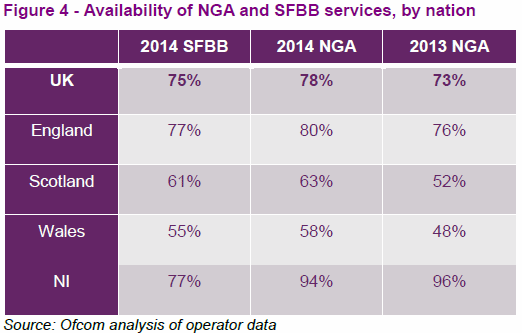

The Government of course expects 95% of the UK to have access to fixed “superfast” broadband speeds over 24Mbit/s by 2017 and 100% are intended to get access to at least 2Mbps by 2016. On the 2Mbps goal it’s estimated that 97% of the UK can already access this speed, although Ofcom would like to see a new minimum of around 10Mbps being set in order to keep pace with the demands of modern households (NOTE: Ofcom estimates that the coverage of broadband faster than 10Mbps has already reached 85%).
It’s worth pointing out that the majority (59%) of connections in the UK are still pure copper line ADSL / ADSL2+ services, while 22% are on Virgin Media’s DOCSIS cable network, 12% have taken FTTC (mostly from BT) and 0.1% are on true fibre optic FTTP (note: more recent data than Ofcom’s suggests that around 250K+ lines are FTTH/P/B).
Unsurprisingly all of this NGA development has also meant that the UK’s average modem “sync” speeds have increased from 17.6Mbps (Megabits per second) last year to 23.4Mbps now. This figure is based more on the best case / predicted performance of a line instead of real-world speedtests and is thus a little higher than the real-world speed of 18.7Mbps reported by Ofcom at the start of this month (here).
Advertisement
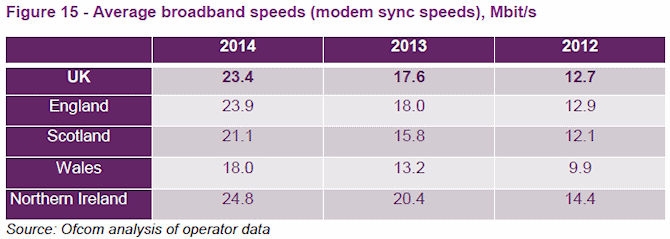
It’s also interesting to see the different performance when we split out Urban and Rural areas. It’s important to stress that rural areas are likely to see more benefit in the future as the related Broadband Delivery UK (BDUK) projects will increasingly turn to focus on them because most of the urban upgrades have already been done.
Take note that being within reach of a NGA connection does not, as some consumers still seem to think, mean you will be upgraded automatically (unless you’re on Virgin Media of course). In most cases you need to pay extra for the faster connection before you can benefit, which is one reason why performance doesn’t always reflect availability.
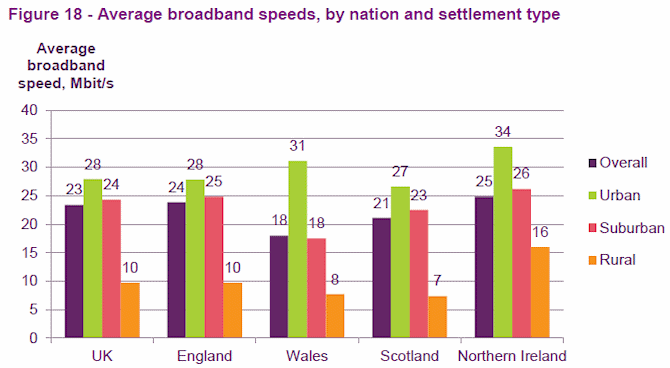
As a result of all this it should come as no surprise to find that fixed line broadband customers in the UK gobbled 58GB (GigaBytes) of data per connection (includes 7GB of uploads), which is up sharply from 30GB last year. The introduction of new video game consoles (Xbox One, PS4 etc.) with huge game download requirements, premium IPTV solutions (NOW TV etc.) and higher quality video streaming (e.g. 4K) has no doubt played a part.
Ofcom also rather handily breaks this figure down by fixed line connection technology.
Advertisement
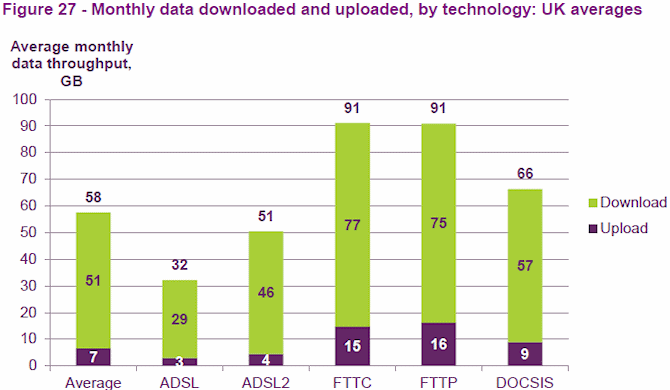
Separately Ofcom also examines the coverage of mobile networks, which found that 99% of “premises” are covered by at least one mobile network operator (MNO) via older style 2G voice platforms. However we suspect that many consumers would strongly disagree with such figures, especially given the reality of patchy-coverage that we all face. Meanwhile 3G coverage is still a bit of a mixed bag.
All four MNOs (Three UK, EE, Vodafone and O2) have outdoor 3G coverage of over 90% of all urban premises. Sadly rural coverage is more varied: O2 covers 62% of rural premises (outdoors), much less than the 90% rural coverage achieved by EE and Three, while Vodafone has the lowest rural coverage at 47%.
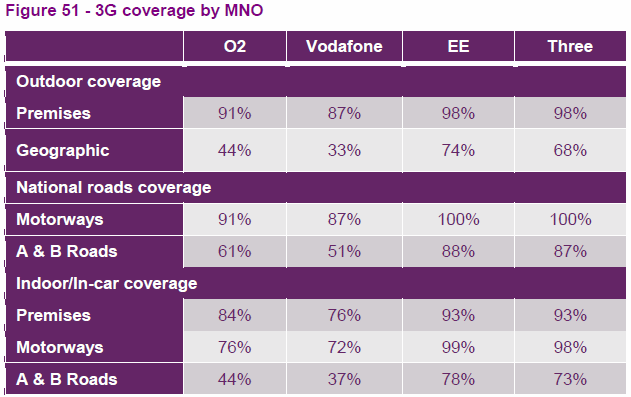
As you’d expect the coverage of 4G, which is still being rolled out, is still fairly feeble and tends to range from around 40% to 68% of the United Kingdom, with EE holding the latter due to being given a head-start on the deployment through the use of their existing 1800MHz band.
Overall mobile broadband (3G / 4G) users gobbled 44.3GB (GigaBytes) of data, which is up from 28.9GB last year and 19.7GB in 2012. Hardly surprising given the rise in demand for all things Internet, coupled to the faster connectivity options that are now available. Crucially this isn’t far behind fixed line consumption.
Finally, Ofcom has launched an updated Interactive Map for displaying fixed line and mobile coverage. But the detail level is far too low for it to be useful and indeed most mobile operators and BDUK project websites have far more detailed maps.
NOTE: Many of the stats in Ofcom’s report are based on data from June 2014.
Ofcom’s 2014 Infrastructure Report (PDF)
http://stakeholders.ofcom.org.uk/market-data-research/market-data/../infrastructure-2014
Mark is a professional technology writer, IT consultant and computer engineer from Dorset (England), he also founded ISPreview in 1999 and enjoys analysing the latest telecoms and broadband developments. Find me on X (Twitter), Mastodon, Facebook, BlueSky, Threads.net and Linkedin.
« UPDATE2 Virgin Media UK Users Hit by Internet Video Buffering Woes Again

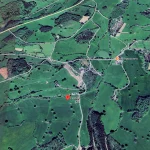
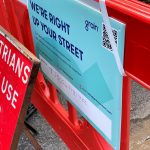

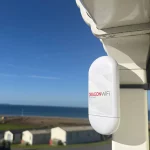












































Comments are closed